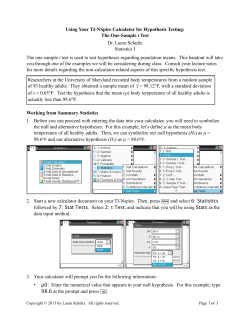
One Sample Tests of Hypothesis Chapter 10 ©The McGraw-Hill Companies, Inc. 2008 McGraw-Hill/Irwin
One Sample Tests of Hypothesis Chapter 10 McGraw-Hill/Irwin ©The McGraw-Hill Companies, Inc. 2008 What is a Hypothesis? A Hypothesis is a statement about the value of a population parameter developed for the purpose of testing. Examples of hypotheses made about a population parameter are: – – 2 The mean monthly income for systems analysts is $3,625. Twenty percent of all customers at Bovine’s Chop House return for another meal within a month. Hypothesis Testing Steps 3 4 Parts of a Distribution in Hypothesis Testing 5 One-tail vs. Two-tail Test 6 Hypothesis Setups for Testing a Mean (µ µ) 7 Testing for a Population Mean with a Known Population Standard Deviation- Example Jamestown Steel Company manufactures and assembles desks and other office equipment at several plants in western New York State. The weekly production of the Model A325 desk at the Fredonia Plant follows the normal probability distribution with a mean of 200 and a standard deviation of 16. Recently, because of market expansion, new production methods have been introduced and new employees hired. The vice president of manufacturing would like to investigate whether there has been a change in the weekly production of the Model A325 desk. 8 Testing for a Population Mean with a Known Population Standard Deviation- Example Step 1: State the null hypothesis and the alternate hypothesis. H0: µ = 200 H1: µ ≠ 200 (note: keyword in the problem “has changed”) Step 2: Select the level of significance. α = 0.01 as stated in the problem Step 3: Select the test statistic. Use Z-distribution since σ is known 9 Testing for a Population Mean with a Known Population Standard Deviation- Example Step 4: Formulate the decision rule. Reject H0 if |Z| > Zα/2 Z > Zα / 2 X −µ > Zα / 2 σ/ n 203.5 − 200 > Z .01/ 2 16 / 50 1.55 is not > 2.58 Step 5: Make a decision and interpret the result. Because 1.55 does not fall in the rejection region, H0 is not rejected. We conclude that the population mean is not different from 200. So we would report to the vice president of manufacturing that the sample evidence does not show that the production rate at the Fredonia Plant has changed from 200 per week. 10 Type of Errors in Hypothesis Testing 11 Type I Error – Defined as the probability of rejecting the null hypothesis when it is actually true. – This is denoted by the Greek letter “α” – Also known as the significance level of a test Type II Error: – Defined as the probability of “accepting” the null hypothesis when it is actually false. – This is denoted by the Greek letter “β” Testing for the Population Mean: Population Standard Deviation Unknown 12 When the population standard deviation (σ) is unknown, the sample standard deviation (s) is used in its place The t-distribution is used as test statistic, which is computed using the formula: Testing for the Population Mean: Population Standard Deviation Unknown - Example The McFarland Insurance Company Claims Department reports the mean cost to process a claim is $60. An industry comparison showed this amount to be larger than most other insurance companies, so the company instituted cost-cutting measures. To evaluate the effect of the cost-cutting measures, the Supervisor of the Claims Department selected a random sample of 26 claims processed last month. The sample information is reported below. At the .01 significance level is it reasonable a claim is now less than $60? 13 Testing for a Population Mean with a Known Population Standard Deviation- Example Step 1: State the null hypothesis and the alternate hypothesis. H0: µ ≥ $60 H1: µ < $60 (note: keyword in the problem “now less than”) Step 2: Select the level of significance. α = 0.01 as stated in the problem Step 3: Select the test statistic. Use t-distribution since σ is unknown 14 t-Distribution Table (portion) 15 Testing for a Population Mean with a Known Population Standard Deviation- Example Step 4: Formulate the decision rule. Reject H0 if t < -tα,n-1 16 Step 5: Make a decision and interpret the result. Because -1.818 does not fall in the rejection region, H0 is not rejected at the .01 significance level. We have not demonstrated that the cost-cutting measures reduced the mean cost per claim to less than $60. The difference of $3.58 ($56.42 - $60) between the sample mean and the population mean could be due to sampling error. End of Chapter 10 17
© Copyright 2025





















